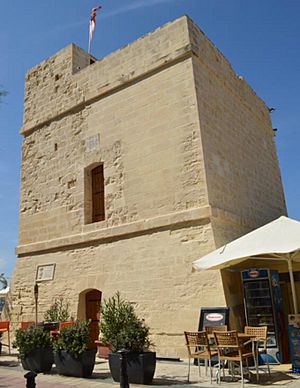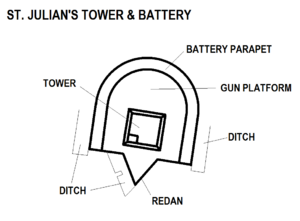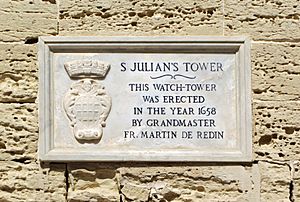Saint Julian's Tower facts for kids
Quick facts for kids Saint Julian's Tower & Battery |
|
|---|---|
| Torri u Batterija ta' San Ġiljan | |
| Part of the De Redin towers | |
| Sliema, Malta | |

Saint Julian's Tower
|
|

Map of St. Julian's Tower & Battery before most of the battery was dismantled
|
|
| Coordinates | 35°55′4.1″N 14°29′57.1″E / 35.917806°N 14.499194°E |
| Type | Coastal watchtower Artillery battery |
| Site information | |
| Owner | Government of Malta |
| Controlled by | It-Torri Restaurant |
| Open to the public |
Yes (as a restaurant) |
| Condition | Tower intact Battery partly intact |
| Site history | |
| Built | 1658 (tower) 1715 (battery) |
| Built by | Order of Saint John |
| Materials | Limestone |
| Battles/wars | Siege of Malta (1798–1800) |
Saint Julian's Tower (Maltese: Torri ta' San Ġiljan), also known as Sliema Tower (Maltese: Torri tas-Sliema), is a small watchtower located in Sliema, Malta. It was finished in 1658 and was the fifth of the De Redin towers built to protect the coast. Later, in 1715, an artillery battery (a place for cannons) was added around the tower. Today, the tower and what remains of the battery are used as a restaurant.
Contents
History of the Tower
Saint Julian's Tower was built in 1658. Its main job was to protect St. Julian's Bay from attacks by sea. The tower looks like other De Redin towers. It has a square shape with two floors and a small turret on its roof. From the tower, you could see Saint George's Tower to the west and the capital city, Valletta, to the east.
Adding the Battery
In 1715, a semi-circular artillery battery was built around the side of the tower facing the sea. This battery had a wall called a parapet with four openings, called embrasures, where cannons could fire through. Other parts of the wall allowed cannons to fire over the top. A separate wall and a triangular part called a redan were built on the land side of the tower. These had small holes for muskets and were protected by a shallow ditch dug into the rock.
Role in the Maltese Uprising
In 1798, the Maltese people rose up against the French who were occupying Malta. During this time, rebels led by Vincenzo Borg took control of Saint Julian's Tower and its battery. Later, during the blockade of the French, the cannons from the battery were moved to other rebel forts. These cannons were then used to fire at the French soldiers in Valletta.
Tower Road and Plaque
The tower gave its name to Tower Road. This road is now one of Malta's most popular walking areas along the sea. In 1951, the Government of Malta placed a special marble plaque on the tower. This plaque shows the coat-of-arms of the Grand Master who ordered the tower to be built.
Present Day Use
Today, Saint Julian's Tower is still standing and is in good condition. However, parts of the battery have changed. The wall and triangular part on the land side are gone, replaced by a promenade (a walking path). Also, the wall with the cannon openings has been taken down and replaced by a low wall.
The tower and the remaining parts of the battery are now used as a restaurant. It is known as It-Torri Restaurant.
See also
 In Spanish: Torre de San Julián (Malta) para niños
In Spanish: Torre de San Julián (Malta) para niños


